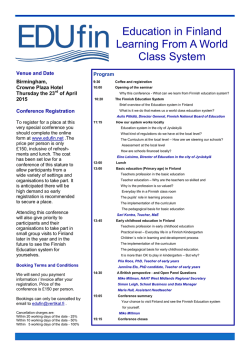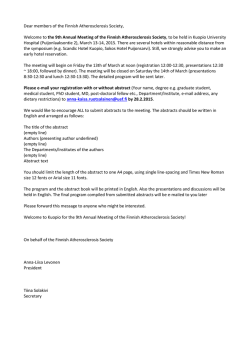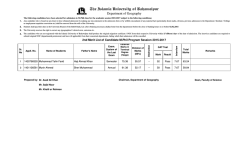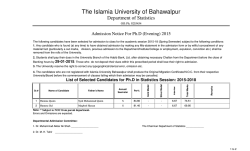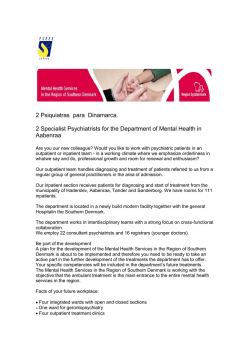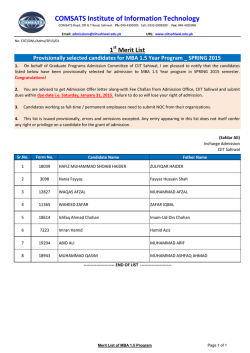
Download Full Text - Harvard University
Long term mental health outcomes of Finnish children evacuated to Swedish families during the second world war and their nonevacuated siblings: cohort study The Harvard community has made this article openly available. Please share how this access benefits you. Your story matters. Citation Santavirta, Torsten, Nina Santavirta, Theresa S Betancourt, and Stephen E Gilman. 2015. “Long term mental health outcomes of Finnish children evacuated to Swedish families during the second world war and their non-evacuated siblings: cohort study.” BMJ : British Medical Journal 350 (1): g7753. doi:10.1136/bmj.g7753. http://dx.doi.org/10.1136/bmj.g7753. Published Version doi:10.1136/bmj.g7753 Accessed February 6, 2015 10:56:28 AM EST Citable Link http://nrs.harvard.edu/urn-3:HUL.InstRepos:13890597 Terms of Use This article was downloaded from Harvard University's DASH repository, and is made available under the terms and conditions applicable to Other Posted Material, as set forth at http://nrs.harvard.edu/urn-3:HUL.InstRepos:dash.current.termsof-use#LAA (Article begins on next page) BMJ 2015;350:g7753 doi: 10.1136/bmj.g7753 (Published 5 January 2015) Page 1 of 9 Research RESEARCH Long term mental health outcomes of Finnish children evacuated to Swedish families during the second world war and their non-evacuated siblings: cohort study OPEN ACCESS 1 2 Torsten Santavirta assistant professor , Nina Santavirta associate professor , Theresa S Betancourt 3 4 associate professor , Stephen E Gilman associate professor Swedish Institute for Social Research, Stockholm University, SE-10691, Stockholm, Sweden; 2Institute of Behavioural Sciences, University of Helsinki, Helsinki, Finland; 3Department of Global Health and Population, Harvard School of Public Health, Boston, MA, USA; 4Department of Social & Behavioral Sciences and Department of Epidemiology, Harvard School of Public Health, Department of Psychiatry, Massachusetts General Hospital, Boston, MA, USA 1 Abstract Objectives To compare the risks of admission to hospital for any type of psychiatric disorder and for four specific psychiatric disorders among adults who as children were evacuated to Swedish foster families during the second world war and their non-evacuated siblings, and to evaluate whether these risks differ between the sexes. Design Cohort study. Setting National child evacuation scheme in Finland during the second world war. Participants Children born in Finland between 1933 and 1944 who were later included in a 10% sample of the 1950 Finnish census ascertained in 1997 (n=45 463; women: n=22 021; men: n=23 442). Evacuees in the sample were identified from war time government records. Main outcome measure Adults admitted to hospital for psychiatric disorders recorded between 1971 and 2011 in the Finnish hospital discharge register. Methods We used Cox proportional hazards models to estimate the association between evacuation to temporary foster care in Sweden during the second world war and admission to hospital for a psychiatric disorder between ages 38 and 78 years. Fixed effects methods were employed to control for all unobserved social and genetic characteristics shared among siblings. Results Among men and women combined, the risk of admission to hospital for a psychiatric disorder did not differ between Finnish adults evacuated to Swedish foster families and their non-evacuated siblings (hazard ratio 0.89, 95% confidence interval 0.64 to 1.26). Evidence suggested a lower risk of admission for any mental disorder (0.67, 0.44 to 1.03) among evacuated men, whereas for women there was no association between evacuation and the overall risk of admission for a psychiatric disorder (1.21, 0.80 to 1.83). When admissions for individual psychiatric disorders were analyzed, evacuated girls were significantly more likely than their non-evacuated sisters to be admitted to hospital for a mood disorder as an adult (2.19, 1.10 to 4.33). Conclusions The Finnish evacuation policy was not associated with an increased overall risk of admission to hospital for a psychiatric disorder in adulthood among former evacuees. In fact, evacuation was associated with a marginally reduced risk of admission for any psychiatric disorder among men. Among women who had been evacuated, however, the risk of being admitted to hospital for a mood disorder was increased. Introduction Children displaced as a result of armed conflicts, human rights abuses, and natural disasters account for up to 5% of the global refugee population; in 2012 alone, more than 21 000 asylum claims were lodged for displaced children.1 Policy responses to this problem must balance two competing factors: the protection of children and the preservation of the family. Wars and natural disasters have direct impacts on children that are harmful to their development2-4; shielding children from these direct impacts often entails separation from their biological parents, but such separation is in itself harmful.5-7 Weighing these alternatives requires a better understanding of the long term consequences, but follow-up studies of long duration are scarce, particularly ones that can overcome strong selection biases associated with the vulnerabilities of families and children.8 We investigated the risk of admission to hospital for a psychiatric disorder among adults who as children experienced Correspondence to: T Santavirta [email protected] Extra material supplied by the author (see http://www.bmj.com/content/350/bmj.g7753?tab=related#datasupp) Appendices ICD codes for psychiatric disorders from Finnish hospital discharge register No commercial reuse: See rights and reprints http://www.bmj.com/permissions Subscribe: http://www.bmj.com/subscribe BMJ 2015;350:g7753 doi: 10.1136/bmj.g7753 (Published 5 January 2015) Page 2 of 9 RESEARCH separation from their families because of a policy designed to shield them from the direct impact of war and whether this risk differed between the sexes. Between 1941 and 1945, approximately 49 000 Finnish children aged 1 to 10 years were evacuated to Swedish foster families to protect them from the direct harms of war, such as air raids, malnutrition, and deaths of family members. Whether this policy conferred long term psychological harms brought about by separation from parents, adjustments to foster families who often spoke an unfamiliar language, and other stressors associated with displacement has been difficult to determine. Our expectation based on early studies of children in war time9 and on contemporary studies of parental loss and separation in the general population, is that these exposures increase the risk of mental health problems, including mood, anxiety, and substance use disorders.10-13 However, the net psychiatric effect of this policy could be either protective or adverse depending on which of the two conflicting needs outweighs the other. In addition, given previous research indicating sex differences in response to the experiences of war,14 15 it is important to evaluate whether the long term mental health consequences of evacuation differs between men and women. The fundamental challenge to evaluating the Finnish policy of child evacuation is identifying a credible comparison group. Simple comparisons of rates of psychiatric disorders between adults evacuated or not evacuated as children cannot be interpreted as the causal effects of evacuation unless it is assumed that both groups were equally likely to be evacuated. However, the historical records suggest that this was not the case—though the war led to adverse conditions for children from all social and economic backgrounds,16 evacuation was likely contingent on a wide range of familial and child characteristics that could be independent risks for psychopathology. The Finnish evacuation policy, according to government guidelines from 1941, targeted children in the following categories: family displaced from the areas ceded to the Soviet Union in 1940 (Karelia), father wounded in battle, family home destroyed in bombings, and father died in the war or parents lost in bombings. Children of mothers working full time or those at risk of air raids were also considered eligible from 1942 onwards.17 Supplementary appendix A provides more detail on the evacuation policy; in particular the historical background, the evacuation from Finland to Sweden, and the placement of children in foster families in Sweden. Determining the long term mental health consequences of the Finnish evacuation is important for understanding the potential benefits and harms associated with such a policy and remains relevant to today’s policy decisions on child refugees globally.18 Methods This study used a within sibling design to evaluate the psychiatric consequences of the Finnish evacuation. We obtained a random sample of the 1933-44 birth cohort followed up to adulthood, compared rates of admissions to hospital for psychiatric disorders between evacuees and their non-evacuated siblings, and investigated sex differences in the association between evacuation and risk of admission for a psychiatric disorder. This design minimizes the selection biases to which small, unrepresentative samples are susceptible19-25 and eliminates a broad category of potential confounding factors: all aspects of the family environment shared among siblings, which could have increased the likelihood of evacuation and independently conferred risk for psychiatric disorders.26 No commercial reuse: See rights and reprints http://www.bmj.com/permissions Study sample The study sample included all people born between 1 January 1933 and 31 December 1944 who participated in the 1950 Finnish census and were selected for inclusion in a 10% follow-up sample conducted by Statistics Finland (n=71 788, sampling was conducted in 1997).27 Using the participants’ social security numbers, we linked their census record to the Finnish hospital discharge register (administered by the National Institute of Health and Welfare), providing data on admissions to hospital covering the years 1971-2011, and to the Finnish causes of death register (administered by Statistics Finland), providing data on the time of death covering the years 1971-2011. The current study included all people in the 10% follow-up sample who had at least one sibling also born between 1933 and 1944 and was living in Finland through 1970. We determined each individual’s evacuation status by comparing the first and last names and exact birth date of participants to the Finnish national archives’ registry of child evacuees, which covers the entire population of evacuees (n=48 682).17 To construct family covariates on background, we also linked the participants’ records to the census data of their parents and their siblings born before 1933; this was done using family identifier variables that were available in the 10% follow-up sample of the 1950 Finnish census. After excluding those with a missing family identifier (n=1136), those who had died or emigrated from Finland before the 1970 census (n=4037), and those in sibling groups of one (n=19 738), our analytic sample consisted of 46 877 people, of whom 1425 had been evacuated to foster families in Sweden during the second world war. Supplementary appendix B provides more detail on the acquisition of data. Measures Evacuation Exposure was defined as a binary variable; we assigned participants a value of 1 if they had been evacuated to foster families in Sweden during the second world war according to the complete child evacuee registry of the Finnish national archives and a value of 0 otherwise. Admissions to hospital for psychiatric disorders Our main outcome of interest was admission to hospital for a psychiatric disorder, obtained from the Finnish hospital discharge register between 1971 and 2011. The register contains information on the exact date of admission and discharge for all inpatient stays of residents in Finland. We used the primary and subsidiary diagnosis codes from the eighth, ninth, and 10th revisions28-30 of the international classification of diseases and deaths (see supplementary table for specific ICD codes). We conducted analyses of admission to hospital for any psychiatric disorder, as well as admission specifically for substance use and for psychotic, mood, and anxiety disorders. The validity of data from the Finnish hospital discharge register has been shown to range from satisfactory to very high, with positive predictive values for common diagnoses ranging between 75% and 98%31; the positive predictive values for mental disorders are 98%,32 for psychotic disorder are 84-100%,33 and for psychotic and bipolar disorders are 88%.34 The psychiatric follow-up period 1971-2011 covered the ages of 38-78 years—that is, the oldest people in the sample were aged 38 in 1971. Subscribe: http://www.bmj.com/subscribe BMJ 2015;350:g7753 doi: 10.1136/bmj.g7753 (Published 5 January 2015) Page 3 of 9 RESEARCH Family sociodemographic characteristics We obtained information on the sociodemographic characteristics of the families from the 1950 census, which contained questions for the specific purpose of retrospectively surveying the pre-war conditions of families—that is, as of 1 September 1939. Family socioeconomic status as of 1 September 1939 was based on the father’s occupation (or mother’s occupation if the father’s occupation was missing), defined as entrepreneurs, white collar workers, blue collar workers, homemakers, and unemployed or out of the labor force. Parental education was defined by whether the father or mother had continued his or her education beyond primary school. Using the birth dates of each child in the family we obtained the number of children in the family as of 1940 and birth order from the 1950 census. Native language was defined by whether the family spoke Finnish or Swedish. We also included county of residence as of 1 September 1939 (including pre-war Karelia as one county). Supplementary appendix C provides the geographical distribution of study sample households across counties in 1939 and 1950. Data analysis Cox proportional hazards regression was used to estimate the risk of a being admitted to hospital for a psychiatric disorder during the follow-up period. The risk set included person time, beginning on the participants’ 38th birthday until the date of first hospital admission, death, or until the end of the follow-up period (31 December 2011), when the oldest participants were aged 78 years. Person time contributed by those who were not admitted to hospital for a psychiatric disorder as of 31 December 2011 was censored on this date or on date of death if death occurred before the end of the follow-up period. Further, we excluded from the analysis those who experienced their first episode or died before age 38 but after 1971 (n=1414). In the analyses of specific categories of mental disorders, participants who were admitted for other disorders were censored on the date of admission. The analyses were performed using Stata 12. Hazard ratios are presented with 95% confidence intervals. The primary exposure variable in these analyses was evacuation status (coded 1 for former evacuees, 0 otherwise). Our empirical strategy was to analyze the entire sample using conventional cohort analyses and to compare these findings with results from within sibling analyses. The conventional cohort analyses included controls for family background factors (father’s socioeconomic status as of 1939, parental education, number of children in the family as of 1940, native language, birth order, and preintervention region of residence as of 1939). We then carried out within sibling analyses using fixed effect models in which the baseline hazard within siblings was held constant while allowing it to differ between those who were not siblings.35 This way we adjusted for all sibling invariant factors (both the family characteristics adjusted for in the cohort analysis and the unobserved ones). The advantage of the within sibling model is that all genetic factors shared by siblings (roughly 50% of all genetic factors) and all shared (observed and unobserved) family background characteristics are held constant. This tackles concerns about confounding by unmeasured family factors that are known predictors of evacuation (for example, whether the father had died or was wounded in the war). Throughout the analyses we adjusted variance estimates to account for within family dependence (each family forms a cluster) because cluster specific effects, such as within sibling fixed effects, will in general not completely control for within cluster error correlation or heteroskedasticity.36 No commercial reuse: See rights and reprints http://www.bmj.com/permissions To test sex differences in the association between evacuation to foster families and mental disorders in adulthood, we included a sex by evacuation status interaction term in the model. We then used the regression coefficients from the main effects of evacuation, sex, and their interaction to examine whether evacuation contributed to a higher risk of mental disorders in adulthood among women than among men and to generate sex specific effects of the evacuation. Results A total of 4341 people, of whom 2456 were men, had episodes of mental disorders during the follow-up period that were severe enough to warrant or contribute to hospital treatment. Roughly 3% of the participants had been evacuated to Sweden during the second world war and spent on average two years living with a foster family. Table 1⇓ presents the sample characteristics for the participants by sex (supplementary appendix D presents these by exposure status for both sexes). Table 2⇓ compares education, occupation, family size, and native language of parents of evacuee and non-evacuee households using the unrestricted sample (including households with one child) and the analytic sample collapsed to household level. The presented estimates are derived from linear probability models (with a binary dependent variable coded 1 if at least one child in the family was evacuated, 0 otherwise) and can be interpreted as percentage point changes (or absolute changes). A similar pattern emerged for both samples, indicating that parents from evacuee households were more likely to have a blue collar occupation, speak native Swedish, and have many children, and less likely to have continued education beyond primary school. Hence the participants of the evacuation program seem to be selected on observable dimensions of family background. Table 3⇓ reports hazard ratios for participants admitted to hospital for mental disorders by evacuation status from the conventional cohort analyses, adjusting for observed background characteristics of the families (0.94, 95% confidence interval 0.79 to 1.12), and from the within sibling analyses adjusting for all observed and unobserved family characteristics shared among siblings (0.89, 0.64 to 1.26). These hazard ratios do not indicate any association between the evacuation and the likelihood of hospital admission for a psychiatric disorder in adulthood. However, the risk of admission for any psychiatric disorder associated with the evacuation differed significantly between men and women (for interaction between evacuation and sex in conventional cohort analysis χ²=4.54, df=1, P=0.033; in the within sibling analysis χ²=4.93, df=1, P=0.026). This was primarily due to the sex×evacuation interaction in the risk of admission to hospital for mood disorders (χ²=4.00, df=1, P=0.046). Therefore the second and third groups of columns in table 3 present hazard ratios for admissions for psychiatric disorders for men and women separately. Among men, the risk of any hospital admission for a psychiatric disorder was marginally lower between former evacuees and their non-evacuated siblings (hazard ratio 0.67, 95% confidence interval 0.44 to 1.03). Hazard ratios for men were most pronounced for admissions involving substance use and psychotic disorders, though in the within sibling analyses these were estimated imprecisely. Among women, there was no association between evacuation and the risk of admission for any psychiatric disorder (1.21, 0.80 to 1.83). However, evacuation was associated with a significantly increased risk of admissions for a mood disorder (2.19, 1.10 to 4.33). Subscribe: http://www.bmj.com/subscribe BMJ 2015;350:g7753 doi: 10.1136/bmj.g7753 (Published 5 January 2015) Page 4 of 9 RESEARCH Supplementary table E-1 presents subgroup analyses by age at evacuation and table E-2 the duration of evacuation. Discussion This study evaluated the long term risks of admission to hospital for any type of psychiatric disorder of adults who as children were evacuated to foster care during the second world war compared with their non-evacuated siblings. Overall, evacuation was not a significant predictor of admission to hospital for a psychiatric disorder. Though the conventional cohort results suggest no association between evacuation and risk of being admitted to hospital for mental disorders, the sibling comparisons suggested that the policy was associated with a lower risk of being admitted for a mental disorder among men. Girls who were evacuated, however, had a significantly increased risk of hospital admission for a mood disorder in adulthood. Our study provides evidence from the first representative sample of Finnish evacuees on the long term mental health outcomes associated with Finland’s child evacuation policy during the second world war. Strengths and limitations of this study Our collection of nationally representative longitudinal census data is unique and makes the data particularly well suited for evaluating long term outcomes of the Finnish child evacuation policy. Firstly, the availability of social security numbers for a random sample of the 1950 census allows for unusually long follow-ups of the participants and thus avoids the problem of potential recall bias that arises when childhood characteristics are retrospectively reported. Secondly, the ability to link participants’ data to the census records of participants’ families provided family background variables for the conventional cohort analysis dating back to the period before the second world war. Thirdly, additional leverage is gained by linking this existing census sample with individual level war time data from a child evacuee registry. In contrast, other studies have reported mixed results between the Finnish child evacuation policy and mental health outcomes,21-24 varying between large adverse associations and none. These studies analyzed the mental health outcomes in adulthood of smaller and unrepresentative samples of former Finnish evacuees and were not able to deal with the fundamental problem of selection into the program—that is, that family background affected the probability of being evacuated, which we tackled here using a within sibling design.21-24 The results of this study should be interpreted in the context of the several limitations. Though the sibling design eliminates a large class of potential confounding factors (those shared by siblings), this study’s results cannot be inferred as causal. Placing a causal interpretation of our within sibling estimates of evacuation requires that exposure—in this case the parental decision to evacuate a specific sibling—was uncorrelated with unobserved sibling specific endowments.26 37 We included age and birth order to adjust for differences between siblings in the family context that potentially could bias our evacuation estimate. None the less the possibility of residual confounding remains. In particular, such confounding could arise if families disproportionately selected their most resilient, or most vulnerable, child for evacuation. The available anecdotal evidence based on recollections of child evacuees does not suggest that this was the case.38 However, neither the child evacuee registry nor official war time documents concerning the evacuee policy provide details about selective behavior within families that evacuated only some of their children; the No commercial reuse: See rights and reprints http://www.bmj.com/permissions actual evacuation decision was considered to be a family matter.39 Low statistical power is a common concern in studies using sibling designs because such designs rely on variations within the family for both exposure and outcome. Thus, in sibling based studies that fail to detect a significant association between exposure and outcome, it is particularly important to evaluate whether this was simply due to lack of power—that is, an imprecisely estimated null hazard ratio value of 1. Even though the sibling sample size was large with 43 665 sibling pairs, only the discordant pairs contributed to the identification of the population variables. Out of 43 665 sibling pairs, 1321 pairs were discordant for evacuation status. The power calculation for a sibling design with varying numbers of siblings per family and time to event outcome is non-trivial.40 41 Thus the absence of a formal test of statistical power suggests caution in the interpretation of the within sibling results. Within sibling analyses may also be particularly susceptible to measurement error in the exposure variable.42 43 However, the evacuation status of participants in the current sample is known with virtually complete accuracy. Only 87 ambiguous matches were found while linking the entire war time registry including 48 628 child evacuees to the 71 788 people of the 1950 census sample belonging to the 1933-44 cohorts. Among these, 71 cases were such that the mismatch seemed to indicate a spelling error in the individuals’ names in either or both of the data sources. These cases were kept in the analysis, but the results remained unchanged when all 87 ambiguous observations were omitted. A potential weakness is that follow-up in this sample began at age 38; it is possible that we might have underestimated the associations between evacuation in childhood and later hospital admission. The extent of this potential underestimation depends on the long term stability of the increased risk of hospital admission among former evacuees. Previous research documents that parental loss strongly increases the risk of juvenile onset of depression but that the risk decreases over time.44 However, a study comparing the decrease in risk for psychopathology after parental death with the same risk after parental separation showed that decline in risk only played a role when bereavement was secondary to death, whereas the risk after parental separation was constant over time.45 Importantly, the current study did not account for differences in children’s experiences during their time in Sweden. The historical record makes clear that there was wide variation in the socioeconomic status of the foster families, given that families from all socioeconomic backgrounds were encouraged to become foster parents—44% were farmers, 27% were from academia, and 16% were working class.16 While this is a strength of the current study in terms of causal inference, in that assignment to specific foster families was effectively random for parent or child characteristics,16 understanding variations in children’s experiences while in foster care in relation to their long term mental health remains an important area for further study. Conclusions The temporary evacuations from Finland intended to protect children from the adversities of war that we studied took place over half a century ago in the context of a world war that permeated throughout Europe. Given the uniqueness of that situation, and that every war arises from different historical and political circumstances,46 47 it is important to consider what lessons can be learned from the experiences of the Finnish Subscribe: http://www.bmj.com/subscribe BMJ 2015;350:g7753 doi: 10.1136/bmj.g7753 (Published 5 January 2015) Page 5 of 9 RESEARCH children that may be relevant for contemporary child protection policies, particularly because of the scarcity of long term follow-up studies of young people exposed to war.48 Perhaps the most directly relevant circumstances today include those in which there are opportunities to remove children from contexts of high exposure to adversity. For example, follow-up studies of children in the Bucharest Early Intervention Project have shown that a foster care intervention significantly improved the social and neurodevelopmental outcomes of children who were previously staying in institutions.49 50 However, that situation is unique in that the Romanian orphans were abandoned at birth and placed in extremely deprived institutions, in contrast with the Finnish children who were sent to foster care from intact families. Foster care is almost always favored over admitting children to the care of an institution in emergency situations, and modern guidelines establish a framework for structuring and monitoring foster care received by displaced children,51 many of which were adhered to in Sweden; our results show that such foster care programs can have important protective effects, especially for younger boys, but possibly less so for girls in the case of depression. That said, these protective effects will invariably be contingent on a positive balance of risk versus protective factors for children’s development that are present during foster care.52 In light of this, it is important to consider potential mechanisms behind the sex differences we observed. There is no evidence to suggest that women were more likely than men to be exposed to abuse during foster care, but this possibility needs to be guarded against in current situations given evidence of higher risks for abuse of girls in foster care situations.53 54 The current results are less directly relevant to situations in which children are considered unaccompanied (“children who have been separated from both parents and other relatives and are not being cared for by an adult”51). This category of children is also at increased risk for mental health problems over the long term, which may be tackled by effective intervention.55-57 In summary, we provide the first exploration of the association between evacuations to foster care arranged by the Finnish evacuation policy and mental disorders in adulthood using nationally representative data and a research design that substantially mitigates selection bias commonly induced by unobserved confounding factors related to family background. We found that the policy was associated with a reduced overall risk of hospital admission for mental disorders in adulthood among men, but with an increased risk of hospital admission for a mood disorder among women. Our finding of opposing signs of the association between evacuation and hospital admission for a psychiatric disorder between men and women is particularly concerning but consistent with studies of mental health interventions for children in conflict situations58 and several recent reviews.18 59 At face value it suggests that sex specific strategies need to be considered when dealing with situations in which children are exposed to war related conflict and family separation. The Finnish evacuation policy was essentially a complex intervention,60 involving multiple components (including separation from parents, removal from war related exposure and danger, adjustment to foster families, and readjustment to own families after the war). Evidence also suggests that girls may have a heightened risk of adverse outcomes when separated from their parents, particularly for depression.15 61 Thus in future studies it remains critically important to investigate whether components of interventions being considered have opposing effects between the sexes. No commercial reuse: See rights and reprints http://www.bmj.com/permissions We thank Lauri Hirvonen and Minna Maier (University of Helsinki) for their assistance with the research; Sanna Malinen, Jukka Mattila, and Satu Nurmi (Statistics Finland); and Jouni Rasilainen (National Institute for Health and Welfare) for help during the data acquisition phase. Contributors: NS and TS acquired the data. TS designed the study and conducted the statistical analyses. All authors contributed to the interpretation of data and preparation of the manuscript, and approved the final version. TS is guarantor. Funding: This work was supported by the Academy of Finland, National Institutes of Health (grant MH087544), and the Signe and Ane Gyllenberg Foundation. TS received additional support from the Tore Browaldh Foundation and the Siamon Foundation. Competing interests: All authors have completed the ICMJE uniform disclosure form at www.icmje.org/coi_disclosure.pdf and declare: this work was supported by the Academy of Finland, the National Institutes of Health (grant MH087544), and the Signe and Ane Gyllenberg Foundation. TS received additional support from the Tore Browaldh Foundation and the Siamon Foundation; no financial relationships with any organisations that might have an interest in the submitted work in the previous three years; no other relationships or activities that could appear to have influenced the submitted work. Ethical approval: This study was approved by the ethics committees of the National Institute of Health and Welfare (THL/1653/5.05.00/2012) and of Statistics Finland (TK53-1500-10). Data were linked with the permission of the appropriate authorities. Data sharing: The analytic dataset and statistical code are available at Statistics Finland but permission to use the data must be granted by Statistics Finland. Permission applications to access data are available at www.tilastokeskus.fi/meta/tietosuoja/kayttolupa_en.html. Transparency: The lead author (TS) affirms that this manuscript is an honest, accurate, and transparent account of the study being reported; that no important aspects of the study have been omitted; and that any discrepancies from the study as planned have been explained. 1 2 3 4 5 6 7 8 9 10 11 12 13 14 15 16 17 18 UNHCR. 2012 Global trends: displacement: the new 21th Century challenge. 2103. www. unhcr.org/51bacb0f9.html. Danese A, Moffitt TE, Harrington H, Milne BJ, Polanczyk G, Pariante CM, et al. Adverse childhood experiences and adult risk factors for age-related disease: depression, inflammation, and clustering of metabolic risk markers. Arch Pediatr Adolesc Med 2009;163:1135-43. Feldman R, Vengrober A. Posttraumatic stress disorder in infants and young children exposed to war-related trauma. J Am Acad Child Adolesc Psychiatry 2011;50:645-58. Green JG, McLaughlin KA, Berglund PA, Gruber MJ, Sampson NA, Zaslavsky AM, et al. Childhood adversities and adult psychiatric disorders in the national comorbidity survey replication I: associations with first onset of DSM-IV disorders. Arch Gen Psychiatry 2010;67:113-23. Gilman SE, Kawachi I, Fitzmaurice GM, Buka SL. Family disruption in childhood and risk of adult depression. Am J Psychiatry 2003;160:939-46. Hjern A, Lindblad F, Vinnerljung B. Suicide, psychiatric illness, and social maladjustment in intercountry adoptees in Sweden: a cohort study. Lancet 2002;360:443-8. Wilcox HC, Kuramoto SJ, Lichtenstein P, Långström N, Brent DA, Runeson B. Psychiatric morbidity, violent crime, and suicide among children and adolescents exposed to parental death. J Am Acad Child Adolesc Psychiatry 2010;49:514-23. Huemer J, Karnik N, Steiner H. Unaccompanied refugee children. Lancet 2009;373:612-4. Freud A, Burlingham D. War and children. Medical War Books, 1943. Gilman SE, Kawachi I, Fitzmaurice GM, Buka SL. Family disruption in childhood and risk of adult depression. Am J Psychiatry 2003;160:939-46. Gilman SE, Ni MY, Dunn EC, Breslau J, McLaughlin KA, Smoller JW, et al. Contributions of the social environment to first-onset and recurrent mania. Mol Psychiatrry 2014; published online 22 Apr. doi:10.1038/mp.2014.36. Morgan C, Kirkbride J, Leff J, Craig T, Hutchinson G, McKenzie K, et al. Parental separation, loss and psychosis in different ethnic groups: a case-control study. Psychol Med 2007;37:495-503. Skeer M, McCormick MC, Normand SL, Buka SL, Gilman SE. A prospective study of familial conflict, psychological stress, and the development of substance use disorders in adolescence. Drug Alcohol Depend 2009;104:65-72. Panter-Brick C, Grimon MP, Eggerman MJ. Caregiver-child mental health: a prospective study in conflict and refugee settings. Child Psychol Psychiatry 2014;55:313-27. Betancourt TS, Borisova II, de la Soudière M, Williamson JJ. Sierra Leone’s child soldiers: war exposures and mental health problems by gender. Adolesc Health 2011;49:21-8. Santavirta T. How large are the effects from temporary changes in family environment: evidence from a child-evacuation program during World War II. Am Econ J Appl Econ 2012;4(3):28-42. Lomu J. Lastensiirtokomitea ja sen arkisto 1941-1949. [The child evacuation committee and its archives 1941-1949.] Publication Series of the National Archives, 1974; No 441:5a. National Archives of Finland. Fazel M, Wheeler J, Danesh J. Prevalence of serious mental disorder in 7000 refugees resettled in western countries: a systematic review. Lancet 2005;365:1309-14. Subscribe: http://www.bmj.com/subscribe BMJ 2015;350:g7753 doi: 10.1136/bmj.g7753 (Published 5 January 2015) Page 6 of 9 RESEARCH What is already known on this topic Refugee children carry a major burden of risk for poor mental health, yet limited research has been done to tackle such mental health needs During the second world war, Finland evacuated around 49 000 children to Swedish foster families to protect them from the direct harms of war Previous studies evaluating the long term effects of the Finnish evacuation policy were subject to confounding biases: evacuation was highly dependent on family characteristics that were themselves likely to increase the risk for mental health problems in children What this study adds The Finnish evacuation policy was not significantly predictive of admission to hospital for a psychiatric disorder during adulthood The policy was associated with a reduced risk of admission to hospital for any mental disorder in adulthood among males, whereas among females the risk of admission for mood disorders was increased 19 20 21 22 23 24 25 26 27 28 29 30 31 32 33 34 35 36 37 38 39 40 41 42 43 Betancourt TS, Salhi C, Buka S, Leaning J, Dunn G, Felton E. Connectedness, social support, and internalising emotional and behavioral problems in adolescents displaced by the Chechen conflict. Disasters 2012;36:635-55. Gilman SE. Invited commentary: the life course epidemiology of depression. Am J Epidemiol 2007;166:1134-7. Pesonen AK, Räikkönen K, Heinonen K, Kajantie E, Forsén T, Eriksson JG. Depressive symptoms in adults separated from their parents as children: a natural experiment during World War II. Am J Epidemiol 2007;166:1126-33. Räikkönen K, Lahti M, Heinonen K, Pesonen AK, Wahlbeck K, Kajantie E, et al. Risk of severe mental disorders in adults separated temporarily from their parents in childhood: the Helsinki birth cohort study. J Psychiatr Res 2011;45:332-8. Räsänen E. Excessive life changes during childhood and their effects on mental and physical health in adulthood. Acta Paedopsychiatr 1992;55:19-24. Santavirta N, Santavirta T. Child protection and adult depression: evaluating the long-term consequences of evacuating children to foster care during World War II. Health Econ 2014;23:253-67. Tennant C, Hurry J, Bebbington P. The relation of childhood separation experiences to adult depressive and anxiety states. Br J Psychiat 1982;141:475-82. Donovan SJ, Susser E. Commentary: advent of sibling designs. Int J Epidemiol 2011;40:345-9. Statistics Finland. Vuoden 1950 väestölaskennan otosaineiston käsikirja. [Handbook of the 1950 census sample.] Handbooks 38. Statistics Finland, 2013. www.stat.fi/tup/julkaisut/ tiedostot/julkaisuluettelo/yksk38_195000_2013_10461_net.pdf. World Health Organization. International statistical classification of diseases, injuries, and causes of death, eighth revision. WHO, 1965. World Health Organization. Manual of the international statistical classification of diseases, injuries, and causes of death, ninth revision, WHO, 1975 World Health Organization. International statistical classification of diseases and related health problems, 10th revision. Vol 1: Tabular list. Vol. 2: Instruction manual. Vol. 3: Index. WHO, 1992. Sund R. Quality of the Finnish hospital discharge register: a systematic review. Scand J Public Health 2012;40:505-15. Keskimäki I, Aro S. Accuracy of data on diagnoses, procedures and accidents in the Finnish hospital discharge register. Int J Health Sci 1991;2:15-21. Isohanni M, Mäkikyrö T, Moring J, Räsänen P, Hakko H, Partanen U, et al. A comparison of clinical and research DSM-III-R diagnoses of schizophrenia in a Finnish national birth cohort. Soc Psychiatry Psychiatr Epidemiol 1997;32:303-8. Perälä J, Suvisaari J, Saarni SI, Kuoppasalmi K, Isometsä E, Pirkola S, et al. Lifetime prevalence of psychotic and bipolar I disorders in a general population. Arch Gen Psychiat 2007;64:19-28. Holt JD, Prentice RL. Survival analysis in twin studies and matched pair experiments. Biometrika 1974;61:17-30. Cameron CA, Miller DL. A practitioner’s guide to cluster-robust inference. J Hum Resour 2015; (In press.) Rosenzweig M, Wolpin K. Sisters, siblings, and mothers: the effect of teen-age childbearing on birth outcomes in a dynamic family context. Econometrica 1995;63:303-26. Lehtiranta L. Matkalla kodista kotiin: sotalapset muistelevat. [On the road from one home to another: recollections by child evacuees]. Pohjola-Norden, 1996. Kavén P. Humanitaarisuuden varjossa: poliittiset tekijät lastensiirroissa Ruotsiin sotiemme aikana ja niiden jälkeen. Doctoral dissertation, Department of Philosophy, History, Culture and Art Studies, Faculty of Arts, University of Helsinki; 2010. English summary available at: https://helda.helsinki.fi/handle/10138/23826?show=full. Gilman SE, Loucks EB. Invited commentary: does the childhood environment influence the association between every X and Y in adulthood? Am J Epidemiol 2012;176;684-98. Gilman SE, Loucks EB. Another casualty of sibling fixed effects analysis of education and health: an informative null, or null information? Soc Sci Med 2014;118:191-3. Bound J, Solon G. Double trouble: on the value of twins-based estimation of returns to schooling. Econ Educ Rev 1999;18:169-82. Frisell T, Öberg S, Kuja-Halkola, R, Sjölander A. Sibling comparison designs—bias from non-shared confounders and measurement error. Epidemiology 2012;23:713-20. No commercial reuse: See rights and reprints http://www.bmj.com/permissions 44 45 46 47 48 49 50 51 52 53 54 55 56 57 58 59 60 61 Jaffee SR, Moffitt TE, Caspi A, Fombonne E, Poulton R, Martin J. Differences in early childhood risk factors for juvenile-onset and adult-onset depression. Arch Gen Psychiat 2002;59:215-22. Kendler KS, Sheth K, Gardner CO, Prescott CA. Childhood parental loss for first-onset of major depression and alcohol dependence: the time-decay of risk and sex differences. Psychol Med 2002;32:1187-94. Tol WA, Barbui C, Galappatti A, Silove D, Betancourt TS, Souza R, et al. Mental health and psychosocial support in humanitarian settings: linking practice and research. Lancet 2011;378:1581-91. Betancourt TS, Khan KT. The mental health of children affected by armed conflict: protective processes and pathways to resilience. Int Rev Psychiatry 2008;20:317-28. Betancourt TS. Attending to the mental health of war-affected children: the need for longitudinal and developmental research perspectives. J Am Acad Child Adolesc Psychiatry 2011;50:323-5. Almas AN, Degnan KA, Radulescu A, Nelson CA 3rd, Zeanah CH, Fox NA. Effects of early intervention and the moderating effects of brain activity on institutionalized children’s social skills at age 8. Proc Natl Acad Sci USA 2012;109(Suppl 2):17228-31. Sheridan MA, Fox NA, Zeanah CH, McLaughlin KA, Nelson CA 3rd. Variation in neural development as a result of exposure to institutionalization early in childhood. Proc Natl Acad Sci USA 2012;109:12927-32. International Committee of the Red Cross. Central Tracing Agency and Protection Division. 2004. Inter-agency guiding principles on unaccompanied and separated children. International Committee of the Red Cross, Central Training Agency and Protection Division. Fazel M, Reed RV, Panter-Brick C, Stein A. Mental health of displaced and refugee children resettled in high-income countries: risk and protective factors. Lancet 2012;379:266-82. Tyler KA, Cauce AM. Perpetrators of early physical and sexual abuse among homeless and runaway adolescents. Child Abuse Neglect 2002;26:1261-74. Nunno MA, Motz JK. The development of an effective response to the abuse of children in out-of-home care. Child Abuse Neglect 1988;12:521-8. Bean TM, Eurelings-Bontekoe E, Spinhoven P. Course and predictors of mental health of unaccompanied refugee minors in the Netherlands: one year follow-up. Soc Sci Med 2007;64:1204-15. Eide K, Hjern A. Unaccompanied refugee children—vulnerability and agency. Acta Paediatr 2013;102:666-8. Vervliet M, Lammertyn J, Broekaert E, Derluyn I. Longitudinal follow-up of the mental health of unaccompanied refugee minors. Eur Child Adolesc Psychiatry 2014;23:337-46. Betancourt TS, Newnham EA, Brennan RT, Verdeli H, Borisova I, Neugebauer R, et al. Moderators of treatment effectiveness for war-affected youth with depression in northern Uganda. J Adolesc Health 2012;51:544-50. Betancourt TS, Meyers-Ohki SE, Charrow AP, Tol WA. Interventions for children affected by war: an ecological perspective on psychosocial support and mental health care. Harvard Rev Psychiatry 2013:21;70-91. Craig P, Dieppe P, Macintyre S, Michie S, Nazareth I, Petticrew M. Developing and evaluating complex interventions: the new Medical Research Council guidance. BMJ 2008;337:979-83. Ni Bhrolchain M, Chappell R, Diamond I, Jameson C. Parental divorce and outcomes for children: evidence and interpretation. Eur Sociol Rev 2000;16:67-91. Accepted: 23 November 2014 Cite this as: BMJ 2015;350:g7753 This is an Open Access article distributed in accordance with the Creative Commons Attribution Non Commercial (CC BY-NC 4.0) license, which permits others to distribute, remix, adapt, build upon this work non-commercially, and license their derivative works on different terms, provided the original work is properly cited and the use is non-commercial. See: http://creativecommons.org/licenses/by-nc/4.0/. Subscribe: http://www.bmj.com/subscribe BMJ 2015;350:g7753 doi: 10.1136/bmj.g7753 (Published 5 January 2015) Page 7 of 9 RESEARCH Tables Table 1| Characteristics of sample by sex. Values are numbers (percentages) unless stated otherwise Characteristics Hospital admission for any mental disorder Women (n=22 021) Men (n=23 442) 1885 (8.6) 2456 (10.5) Mean years of follow-up Mean (SD) No not admitted to hospital (censored) 33.69 (5.81) (n=20 136) 31.52 (7.98) (n=20 986) Mean (SD) first hospital admission for episode 17.55 (10.48) (n=1885) 17.32 (10.16) (n=2456) 21 385 (97.1) 22,653 (96.6) Not evacuated (within evacuee families) 492 (2.2) 528 (2.3) Evacuated 636 (2.9) 789 (3.4) 1.81 (1.10) (n=634) 1.83 (1.09) (n=783) ≤2 421 (66.40) 516 (65.90) >2 213 (33.60) 267 (34.10) 6.27 (2.53) (n=634) 6.22 (2.45) (n=784) <4 139 (21.9) 154 (19.6) 4-6 235 (37.1) 329 (42.0) 7-11 260 (41.0) 301 (38.4) Entrepreneur 6621 (30.1) 7090 (30.2) White collar worker 2079 (9.4) 2292 (9.8) Blue collar worker 6505 (29.5) 6789 (29.0) Evacuation program Not evacuated Mean (SD) duration of evacuation (years) Duration groups (years): Mean (SD) age at evacuation (years) Age groups (years): Family background Socioeconomic status in 1939*: Homemaker 1941 (8.8) 1976 (8.4) Unemployed or out of labor force 4875 (22.1) 5295 (22.6) Primary school or less 20 541 (93.3) 21 731 (92.7) Beyond primary school 1480 (6.7) 1711 (7.3) 1.90 (1.80) (n=22 021) 1.95 (1.81) (n=23 442) Finnish 20 859 (94.7) 22 125 (94.4) Swedish 1162 (5.3) 1317 (5.6) Parental education†: Mean (SD) No of children in family in 1940 Native language: *Based on father’s occupation; if missing, replaced by mother’s occupation. †Highest level of schooling of either mother or father. No commercial reuse: See rights and reprints http://www.bmj.com/permissions Subscribe: http://www.bmj.com/subscribe BMJ 2015;350:g7753 doi: 10.1136/bmj.g7753 (Published 5 January 2015) Page 8 of 9 RESEARCH Table 2| Evidence on evacuee selection: regressing an indicator variable for whether evacuees in household (value of 1 if yes) on family background characteristics All households Households with >1 sibling Control mean Dependent variable: evacuee status of household Control mean Dependent variable: evacuee status of household Parental education (past primary school=1) 0.078 −0.015 (0.004) 0.078 −0.019 No of children in family as of 1940 1.31 0.017 (<0.001) 1.73 0.014 (0.001) Swedish speaking 0.069 0.046 (0.007) 0.062 0.069 (0.012) Occupation (blue collar worker=1) 0.308 0.038 (0.003) 0.294 0.052 (0.004) No of observations 37 193 38 765 17 993 19 027 Variables Sample means of background characteristics for control group of households without evacuees and linear probability model estimates for all households are reported with robust standard errors of estimates in parentheses. No commercial reuse: See rights and reprints http://www.bmj.com/permissions Subscribe: http://www.bmj.com/subscribe BMJ 2015;350:g7753 doi: 10.1136/bmj.g7753 (Published 5 January 2015) Page 9 of 9 RESEARCH Table 3| Hazard ratios (95% confidence intervals) for risk of hospital admission for a psychiatric disorder between ages 38 and 78 (1971-2011) according to evacuee status as a child during second world war Mental disorder Evacuee status* Full sample (n=45 463) Women (n=22 021) Men (n=23 442) Cohort Within sibling Cohort Within sibling Cohort Within sibling Any disorder Evacuee 0.94 (0.79 to 1.12) 0.89 (0.64 to 1.26) 1.16 (0.90 to 1.49) 1.21 (0.80 to 1.83) 0.80 (0.63 to 1.02) 0.67 (0.44 to 1.03) Substance misuse Evacuee 0.85 (0.65 to 1.11) 0.58 (0.33 to 1.03) 0.93 (0.58 to 1.47) 0.70 (0.33 to 1.49) 0.82 (0.59 to 1.13) 0.52 (0.25 to 1.08) Psychosis Evacuee 0.81 (0.55 to 1.19) 0.67 (0.35 to 1.29) 1.00 (0.60 to 1.64) 1.13 (0.46 to 2.81) 0.64 (0.35 to 1.17) 0.44 (0.18 to 1.09) Mood Evacuee 1.09 (0.83 to 1.43) 1.39 (0.82 to 2.37) 1.38 (0.97 to 1.97) 2.19 (1.10 to 4.33) 0.83 (0.54 to 1.27) 0.90 (0.44 to 1.83) Anxiety Evacuee 1.20 (0.86 to 1.67) 1.36 (0.73 to 2.54) 1.37 (0.88 to 2.12) 1.55 (0.72 to 3.36) 1.03 (0.63 to 1.70) 1.14 (0.52 to 2.52) Effects by sex were derived from one model by including an interaction with evacuee status. Sex composition of analytic sample (n=45 463) reported in table; 1321 sibling pairs were discordant for exposure. Cohort analysis adjusted for sex and its interaction with evacuee status, parental education, native language, number of children in 1940, five categorical variables for socioeconomic status in 1939 and county of residence in 1939, interaction terms between sex and each of five categorical socioeconomic variables, age (birth cohort), birth order, and region of residence (1939) (full sample results in first two columns omit interaction terms with sex). Within sibling analyses used a sibling group specific baseline hazard. All family background covariates—parental education, native language, number of children in 1940, five categorical variables for socioeconomic status in 1939, and county of residence in 1939—cancel out in within sibling analysis. Cluster robust standard errors are adjusted for familial clustering. *Reference category is non-evacuated participants. No commercial reuse: See rights and reprints http://www.bmj.com/permissions Subscribe: http://www.bmj.com/subscribe
© Copyright 2026
